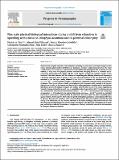Por favor, use este identificador para citar o enlazar a este item:
http://hdl.handle.net/10261/323839COMPARTIR / EXPORTAR:
 SHARE SHARE
 CORE
BASE CORE
BASE
|
|
| Visualizar otros formatos: MARC | Dublin Core | RDF | ORE | MODS | METS | DIDL | DATACITE | |

| Título: | Fine scale physical-biological interactions during a shift from relaxation to upwelling with a focus on Dinophysis acuminata and its potential ciliate prey. |
Autor: | Díaz, Patricio Andrés; Ruiz-Villarreal, Manuel CSIC ORCID ; Mouriño-Carballido, Beatriz; Fernández-Pena, Concepción; Riobó, Pilar CSIC ORCID; Reguera Ramírez, Beatriz CSIC ORCID CVN | Palabras clave: | Medio Marino y Protección Ambiental Centro Oceanográfico de Vigo Dinophysis acuminata Potential ciliate prey Physical-biological interactions Fine scale structure Turbulence division rates Circadian variability Galician Rías |
Fecha de publicación: | 2019 | Editor: | Elsevier BV | Resumen: | Wind reversals and quick transitions from relaxation to upwelling in coastal areas cause major changes in water column structure, phytoplankton distribution and dominance, and rates of physiological processes. The cruise “ASIMUTH-Rías” (17–21 June 2013) was carried out in the Galician Rías and adjacent shelf, at the time of a DSP outbreak, to study small-scale physical processes associated with late spring blooms of D. acuminata and accompanying microzooplanktonic ciliates with the overall objective of improving predictive models of their occurrence. The cruise coincided with the initiation of an upwelling pulse following relaxation and deepening of a previously formed thin layer of diatoms. A 36-h cell cycle study carried on 18–20 June showed the vertical excursions of the thin layer, mainly delimited by the 13.5–14 °C isotherms and turbulence levels (ε) of 10−8–10−6 m2 s−3, as well as marked changes in phytoplankton composition (increased density and dominance of diatoms). There was no evidence of daily vertical migration of D. acuminata, which remained in the top layer during the cycle study, but the opposite was observed in the ciliate populations. Dinophysis and its potential prey (Mesodinium species) cell maxima overlapped after midday, when the ciliate moved to the surface, suggesting an “ambush” strategy of Dinophysis to catch prey. A remarkable decline (from 0.65 to 0.33 d−1) in division rates (µ) of D. acuminata was associated with increased turbulence (ε < 10−4 m2 s−3) near the surface and a sharp drop of temperature (>2°C in about 8 h). In contrast, high division rates (µmin ∼ 0.69 d−1) persisted at a mid-shelf station where environmental conditions below the mixed layer were more stable. The onset of upwelling pulses appears to have a double negative effect on the net growth of Dinophysis populations: a direct physical effect due to advective dispersion and an indirect effect, decreased division rates. The latter would be caused by the rapid cooling of the mixed layer, and the increased turbulence at the surface resulting in shear stress to the cells. The short-term impact of upwelling pulses (and the winds promoting it) on the physiology of Dinophysis and its ciliate prey, and the role of mid-shelf populations of Dinophysis as a relatively undisturbed reservoir for the inoculation of subsequent blooms are discussed. | Versión del editor: | https://www.sciencedirect.com/science/article/pii/S0079661117303087?via%3Dihub | URI: | http://hdl.handle.net/10261/323839 | DOI: | 10.1016/j.pocean.2019.04.009 | ISSN: | 0079-6611 |
| Aparece en las colecciones: | (IEO) Artículos |
Ficheros en este ítem:
| Fichero | Descripción | Tamaño | Formato | |
|---|---|---|---|---|
| 1-s2.0-S0079661117303087-main.pdf | 14,02 MB | Adobe PDF |  Visualizar/Abrir |
CORE Recommender
SCOPUSTM
Citations
14
checked on 20-abr-2024
WEB OF SCIENCETM
Citations
13
checked on 26-feb-2024
Page view(s)
11
checked on 03-may-2024
Download(s)
8
checked on 03-may-2024
Google ScholarTM
Check
Altmetric
Altmetric
Este item está licenciado bajo una Licencia Creative Commons

